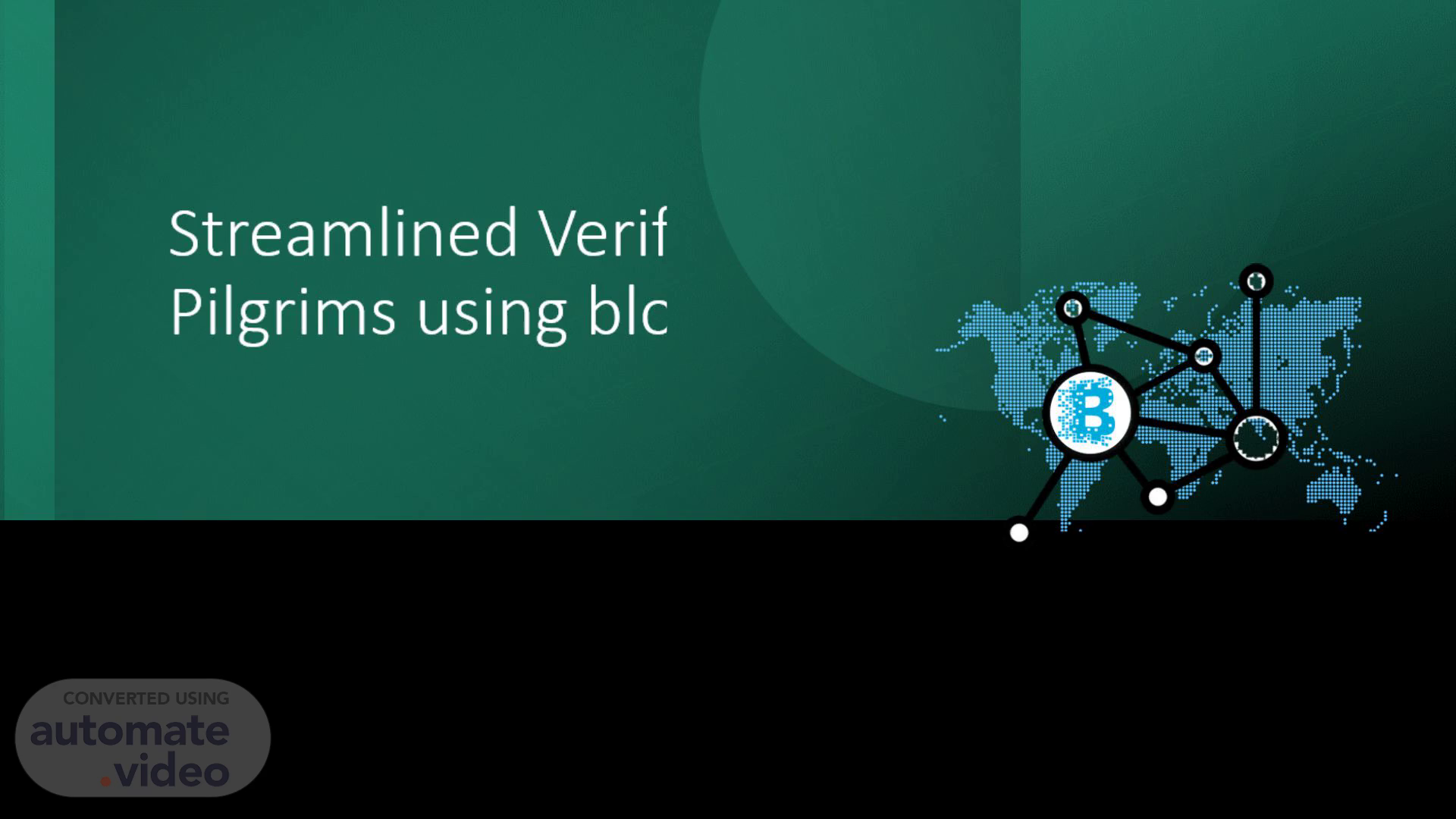
Streamlined Verification Processes for Pilgrims using blockchain
Scene 1 (0s)
Streamlined Verification Processes for Pilgrims using blockchain.
Scene 2 (3s)
Introduction. Embarking on a pilgrimage is a profound journey of spirituality and self-discovery. However, pilgrims often encounter significant challenges during the process of identity verification at various checkpoints. In this presentation, we delve into the obstacles faced by pilgrims and explore the transformative potential of efficient identity verification processes. Join us as we navigate the intersection of spirituality and technology to enhance the pilgrimage experience through streamlined verification solutions..
Scene 3 (27s)
Challenges in Pilgrim Identity Verification. Long Queues: Pilgrims often face extensive queues at transportation hubs, accommodation facilities, and entry points to pilgrimage sites. Manual Processes: Traditional identity verification methods involve time-consuming manual processes, leading to delays in the pilgrimage journey. Security Concerns: Conventional methods may be susceptible to identity theft or fraudulent activities, compromising the security of pilgrims..
Scene 4 (48s)
Importance of Efficient Verification Processes. Enhanced Experience: Efficient identity verification contributes to a seamless and enjoyable pilgrimage experience for participants. Reduced Wait Times: Streamlined processes using blockchain ensure quicker verification, minimizing wait times at checkpoints. Optimized Resource Utilization: Efficient verification allows pilgrims to make better use of their time and resources during the journey. Overall Journey Satisfaction: A smooth identity verification process positively influences the overall satisfaction of pilgrims, fostering a positive perception of the pilgrimage..
Scene 5 (1m 11s)
Impact on Pilgrim Experience. Minimized Stress: Quick and hassle-free identity verification reduces stress and anxiety among pilgrims. Improved Accessibility: Pilgrims can access transportation, accommodations, and pilgrimage sites more conveniently with efficient verification. Cultural and Spiritual Focus: Streamlined processes enable pilgrims to focus more on the cultural and spiritual aspects of their journey rather than administrative hurdles..
Scene 6 (1m 32s)
How Blockchain Works for Pilgrims. Decentralization: Blockchain operates on a decentralized network, eliminating the need for a central authority. Pilgrims' identity data is stored across multiple nodes, enhancing security and resilience against single points of failure. Immutable Ledger: Pilgrims' identity information is recorded in blocks that are linked in a chain. Once a block is added to the chain, it becomes immutable, ensuring the integrity and permanence of the stored data. Secure Access through Cryptography: Pilgrims' identity is protected using cryptographic techniques, involving private and public keys. Private keys provide secure access to personal information, while public keys facilitate transparent and secure verification processes..
Scene 7 (2m 2s)
Benefits of Streamlined Verification. Time Efficiency: Blockchain-based identity management significantly reduces the time required for identity verification. Cost Savings: Streamlining processes can lead to cost savings for both pilgrims and pilgrimage organizers. Data Security: Blockchain's secure and decentralized nature enhances the protection of pilgrims' identity information..
Scene 8 (2m 19s)
Pilgrim-Centric Approach. User-Friendly Systems: Implementing user-friendly blockchain-based systems ensures accessibility for pilgrims of all backgrounds and technological expertise. Integration with Pilgrimage Apps: Seamless integration with pilgrimage apps for easy navigation and real-time updates on verification status..
Scene 9 (2m 35s)
Collaborative Solutions. Industry Collaboration: Collaboration among transportation providers, accommodation facilities, and pilgrimage sites to implement a standardized, interoperable blockchain identity system. Government Involvement: Involvement of government authorities to establish regulatory frameworks supporting blockchain-based identity verification for pilgrims..
Scene 10 (2m 50s)
Real-world Implementation. Implementation: Authorities overseeing the Hajj pilgrimage in Saudi Arabia leverage blockchain for identity verification. Positive Outcomes: Blockchain expedites the processing of millions of pilgrims, leading to a more organized and secure pilgrimage. Feedback: Pilgrims acknowledge the positive impact on their overall experience, with a notable reduction in queues and streamlined access to key pilgrimage sites..
Scene 11 (3m 10s)
Conclusion. Transformative Potential: Efficient identity verification processes using blockchain have the potential to transform the pilgrimage experience. Positive Impact: The adoption of streamlined verification contributes to the positive perception and satisfaction of pilgrims during their spiritual journey..
Scene 12 (3m 24s)
Any questions?.
Scene 13 (3m 31s)
Team members. 1. Blockchain Developer - Maryam: As the lead blockchain developer, Maryam will be responsible for designing and implementing the blockchain-based identity management system. She will work on creating smart contracts, defining the data structure for identity verification, and ensuring the security and integrity of the blockchain network. Maryam will collaborate with the other team members to integrate the blockchain solution seamlessly into the pilgrimage verification processes. 2. UX/UI Designer - Tahir: Tahir, as the UX/UI designer, will focus on creating an intuitive and user-friendly interface for both pilgrims and the verification checkpoint personnel. He will conduct user research, design wireframes, and develop visually appealing interfaces that enhance the overall user experience. Tahir's goal is to simplify the identity verification process, making it accessible and efficient for pilgrims and easy to manage for the verification personnel. 3. Project Manager – Taha: As the project manager, Taha will oversee the entire development process, ensuring that the project stays on schedule and within budget. He will be responsible for coordinating the efforts of the team members, setting project milestones, and managing resources effectively. Taha will also act as the bridge between the development team and stakeholders, ensuring that the final product aligns with the initial vision and meets the needs of the pilgrims and verification checkpoints..